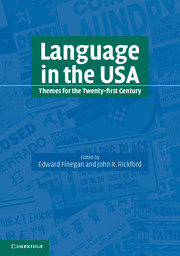Book contents
- Frontmatter
- Contents
- List of figures
- List of tables
- List of contributors
- Acknowledgments
- Foreword
- Editors' preface
- Part 1 American English
- Part 2 Other language varieties
- 7 Multilingualism and non-English mother tongues
- 8 Creole languages: forging new identities
- 9 Native American languages
- 10 Spanish in the Northeast
- 11 Spanish in the Southwest
- 12 American Sign Language
- 13 Asian American voices: language in the Asian American community
- 14 Linguistic diversity and English language acquisition
- Part 3 The sociolinguistic situation
- Index
11 - Spanish in the Southwest
Published online by Cambridge University Press: 05 June 2012
- Frontmatter
- Contents
- List of figures
- List of tables
- List of contributors
- Acknowledgments
- Foreword
- Editors' preface
- Part 1 American English
- Part 2 Other language varieties
- 7 Multilingualism and non-English mother tongues
- 8 Creole languages: forging new identities
- 9 Native American languages
- 10 Spanish in the Northeast
- 11 Spanish in the Southwest
- 12 American Sign Language
- 13 Asian American voices: language in the Asian American community
- 14 Linguistic diversity and English language acquisition
- Part 3 The sociolinguistic situation
- Index
Summary
Editors' introduction
Spanish has a long history in the Southwest. States such as California and Colorado take their names from Spanish, as do state capitals including Sacramento and Santa Fe (New Mexico), as well as hundreds and hundreds of cities and towns and the nearby rivers and mountain ranges. Spanish has contributed many words for everyday phenomena as well. Beginning with its earliest arrival in Florida on the ships of Ponce de León, Spanish has played a central role in American culture, as Carmen Silva-Corvalán describes in this chapter. More than 18 percent of the population of the combined Southwest states (Arizona, California, Colorado, New Mexico, Texas) claim Spanish as a spoken language. Contrary to the misleading view propagated in the mass media, Hispanic-origin Spanish speakers in the Southwest carry strongly positive attitudes toward English. In the 1990 Census, 73 percent of those who identified themselves as speaking Spanish at home also said they spoke English well, leaving only 27 percent who did not.
The contribution of Spanish to the English vocabulary (e.g., adobe, burro, mustang, patio, ranch) is but one indication of an intimate relationship between Spanish speakers and English speakers. During the twentieth century, English contributed more vocabulary items to Spanish than the other way around, but through the first half of the nineteenth century Spanish was the prestige language of the Southwest and the greater contributor. Unlike the Spanish of the Northeast, which echoes Spanish varieties of several nationalities (see chapter 10), the Spanish of the Southwest is basically a variety of Mexican Spanish, though with noticeable English influence on its vocabulary.
- Type
- Chapter
- Information
- Language in the USAThemes for the Twenty-first Century, pp. 205 - 229Publisher: Cambridge University PressPrint publication year: 2004
- 15
- Cited by

